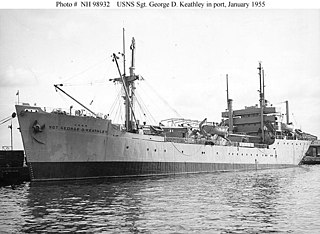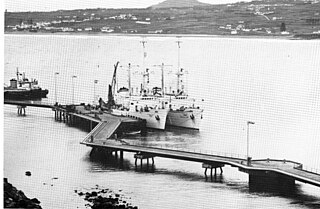
USNS Kingsport (T-AG-164) was built as SS Kingsport Victory, a United States Maritime Commission VC2-S-AP3 (Victory) type cargo ship. During the closing days of World War II the ship was operated by the American Hawaiian Steamship Company under an agreement with the War Shipping Administration. After a period of layup the ship was operated as USAT Kingsport Victory by the Army under bareboat charter effective 8 July 1948. When Army transports were transferred to the Navy's Military Sea Transportation Service the ship continued as USNS Kingsport Victory (T-AK-239), a cargo transport. On 14 November 1961, after conversion into the first satellite communication ship, the ship was renamed Kingsport, reclassified as a general auxiliary, and operated as USNS Kingsport (T-AG-164).

USNS Mizar (MA-48/T-AGOR-11/T-AK-272) was a vessel of the United States Navy. She was named after the star Mizar.

BRP Gregorio Velasquez is Philippine Navy's first oceanographic research vessel. It was built by the United States Navy as USNS Melville (T-AGOR-14) for university support of Navy programs. The ship was operated as the research vessel R/V Melville by the Scripps Institution of Oceanography for oceanographic research. As the R/V Melville, it was the oldest active vessel in the academic research fleet, collectively known as the University-National Oceanographic Laboratory System (UNOLS) (UNOLS). The US Government confirmed on 17 November 2015 that the Melville was to be transferred to the Philippine Navy as Excess Defense Articles (EDA)s. The vessel was officially transferred to the Philippines on 28 April 2016 and was commissioned into active service at the same time with the Philippine Navy.

NOAAS Oceanographer, originally USC&GS Oceanographer, was an American Oceanographer-class oceanographic research vessel in service in the United States Coast and Geodetic Survey from 1966 to 1970 and in the National Oceanic and Atmospheric Administration (NOAA) from 1970 to 1996. She served as flagship of both the Coast and Geodetic Survey and NOAA fleets.
The Naval Oceanographic Office (NAVOCEANO), located at John C. Stennis Space Center in south Mississippi, comprises approximately 1,000 civilian, military and contract personnel responsible for providing oceanographic products and services to all elements within the Department of Defense.

USNS Henson (T-AGS-63) is a Pathfinder-class oceanographic survey ship. It is the fourth ship in the class. Henson is named after Matthew Henson, who accompanied Robert Peary, most famously on an expedition intended to reach the Geographic North Pole in 1909.

USNS Bowditch (T-AGS-21) was the lead ship of her class of oceanographic survey ships for the United States Navy. Launched as the SS South Bend Victory in 1945, Maritime Commission hull number MCV 694, a type VC2-S-AP3 Victory ship, she was named for Nathaniel Bowditch, the second U.S. Navy vessel named in his honor. The ship was acquired by the Navy in August 1957 and converted to an AGS at Charleston Naval Shipyard. Named Bowditch on 8 August 1957 and placed in service 8 October 1958 for operation by the Military Sea Transportation Service (MSTS).
USNS Michelson (T-AGS-23) was a Bowditch class oceanographic survey ship of the United States Navy. Launched as the SS Joliet Victory in 1944, Maritime Commission hull number MCV 114, a type VC2-S-AP3 Victory ship, she was named after Albert Abraham Michelson. The ship was reactivated from the James River Maritime Administration Reserve Fleet on 8 February 1958, delivered to the Navy Department at the Philadelphia Naval Shipyard on 8 August 1957 and converted to an AGS by the Charleston Naval Shipyard. USNS Michelson (AGS‑23) was placed in service on 15 December 1958 under the operational control of MSTS Atlantic.

USS Chain (ARS-20/T-AGOR-17) was a Diver-class rescue and salvage ship commissioned by the U.S. Navy during World War II. Her task was to come to the aid of stricken vessels.

USNS Wyman (T-AGS-34) was an oceanographic survey vessel laid down on 18 July 1968 by the Defoe Shipbuilding Company of Bay City, Michigan. Launched on 30 October 1969, sponsored by Mrs. Francis J. Blouin, wife of the Deputy Chief of Naval Operations, Vice Admiral Francis J. Blouin; she was accepted by the Military Sealift Command (MSC) on 19 November 1971 at the Boston Naval Shipyard.

USNS Sgt. George D. Keathley, was a World War II United States cargo vessel that was used for troop transport and later converted to a survey vessel. She was laid down and launched as MS Alexander R. Nininger, Jr., then renamed MS Acorn Knot. She was put into US Army service as USAT Acorn Knot, then renamed USAT Sgt. George D. Keathley. She was transferred to the US Navy and became USNS Sgt. George D. Keathley (T-APC-117), but was later re-designated T-AGS-35. She was leased to the Republic of China, where she served as Chu Hwa (AGS-564). Both Nininger and Keathley were posthumous Medal of Honor recipients.

USNS Sgt. Curtis F. Shoup (T-AG-175) was a C1-M-AV1 coastal freighter. Built as Spindle Eye, one of the many named for knots. The ship, modified to be a "news transmission ship" for the press during the planned invasion of Japan, was completed 9 July 1945, delivered to the War Shipping Administration and placed under its agent Lykes Brothers Steamship Company the same day. Days later, on 26 July, Spindle Eye was bareboat chartered to the War Department for operation by the Army. The ship was renamed November 1947 by the Army, after serving as a radio relay ship at the Operation Crossroads atomic bomb tests and conversion to an Army passenger-cargo vessel, Sgt. Curtis F. Shoup in honor Sergeant Curtis F. Shoup who had been awarded the Medal of Honor.

USS San Carlos (AVP-51) was a Barnegat-class seaplane tender built for the United States Navy during World War II. San Carlos, named after San Carlos Bay, Florida, was in commissioned from 1944 to 1947 and earned three battle stars for service in the Pacific during World War II. After eleven years in reserve, San Carlos was converted to oceanographic research ship USNS Josiah Willard Gibbs (T-AGOR-1)—named after American scientist Josiah Willard Gibbs—and placed in service as a non-commissioned ship of the Military Sea Transportation Service from 1958 to 1971. In December 1971, the ship was transferred to the Hellenic Navy as Hephaistos (A413), a motor torpedo boat tender. Hephaistos was struck from the rolls of the Hellenic Navy in April 1976.

USNS James M. Gilliss (T-AGOR-4) was a Robert D. Conrad-class oceanographic research ship acquired by the U.S. Navy in 1962. The ship was operated by the Military Sea Transportation Service and managed by the Naval Oceanographic Office as one of the "Navy Pool" vessels serving various Navy laboratories and projects in the Atlantic Ocean. After active Navy pool service the ship was assigned to the University of Miami to operate as part of the University-National Oceanographic Laboratory System (UNOLS) fleet until 1979.

USNS Sands (T-AGOR-6) was a Robert D. Conrad-class oceanographic research ship operated by the Military Sealift Command (MSC) for the Naval Oceanographic Office from 1965 to 1973. During that period she provided ocean-bottom information and underwater test data to the U.S. Navy and other U.S. agencies. The ship was the second naval vessel to be named for Rear Admiral Benjamin F. Sands and his son Rear Admiral James H. Sands, the first being the destroyer Sands (DD-243). The ship operated in the Atlantic on oceanographic and geophysical assignments for the Oceanographic Office and other agencies.

USNS Lynch (T-AGOR-7) was a Robert D. Conrad-class oceanographic research ship that served the United States Navy from 1965 to 1994. During that period the ship was one of the ships under the technical direction of the Naval Oceanographic Office (NAVOCEANO) operating as an Auxiliary General Oceanographic Research (AGOR) program "pool" ship for support of Navy laboratories on each coast as well as NAVOCEANO projects. Lynch was assigned to support laboratories on the East Coast.

USNS Eltanin (T-AK-270/T-AGOR-8) was an Eltanin-class cargo ship with an ice-breaking hull acquired by the U.S. Navy in 1957 and then operated by the Navy in a non-commissioned status, named after Eltanin, a star in the constellation Draco. Her designation was changed to that of an oceanographic research ship in 1962 when she operated in Antarctic waters.

USNS De Steiguer (T-AGOR-12) was a Robert D. Conrad-class oceanographic research ship acquired by the U.S. Navy in 1966. She was a Navy pool vessel assigned to Naval laboratories until she was transferred to the Tunisian Navy in 1992.

John Russell Bartlett (1843–1904) was an American naval officer and oceanographer.

USNS Chauvenet (T-AGS-29) was a multi-function survey ship laid down on 24 May 1967, at Upper Clyde Shipbuilding Corp., Glasgow, Scotland. The ship was the second survey ship, Chauvenet (AGS-11) being the first, named for William Chauvenet (1820-1870). He was instrumental in the founding of the United States Naval Academy at Annapolis, MD. The mathematics department of the US Naval Academy in Annapolis was founded by Chauvenet and is housed in Chauvenet Hall. Chauvenet was launched on 13 May 1968, delivered to the US Navy, 13 November 1970 and placed in service with the Military Sealift Command (MSC) as USNS Chauvenet (T-AGS-29). The ship conducted coastal hydrographic and topographic surveys under the technical direction of the Oceanographer of the Navy through the U.S. Naval Oceanographic Office (NAVOCEANO). The ship was assigned to the Pacific for surveys, sister ship Harkness (T-AGS-32) was assigned Atlantic duties, doing so until inactivated in November 1992.


















